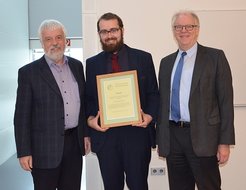Award ceremony at the Institute: Markus Leutzsch wins the Turck Prize

This December the Max-Planck-Institut für Kohlenforschung hosted an exceptional Institute Seminar in a pre-Christmas atmosphere. During this event the Turck Prize for the promotion of young academics was awarded for the first time. Accordingly the interest was high, and the grand lecture hall was packed with staff and visitors.
The Turck Prize honors the best publication of the year authored by a young scientist. The prize money of 2000 Euro is donated by the Hans Turck GmbH & Co. KG. The company is based in Mülheim an der Ruhr, but is active worldwide in the field of industrial automation technology. This year the Prize goes to Markus Leutzsch who has just successfully defended his dissertation. The award is for his contribution to the characterization of an unexpected ruthenium carbene intermediate, generated by geminal hydrogen transfer, with the use of Nuclear Magnetic Resonance (NMR) spectroscopy. The publication appeared recently in the journal “Angewandte Chemie” and received “VIP” status. This means that the referees of the journal judge the communication to be very important.
The Managing Director, Walter Thiel, handed over the award. In a short speech he congratulated Markus Leutzsch and emphasized the impressive achievements that are possible when several departments join forces in a project. The honored publication results from a cooperation of the groups of Alois Fürstner, Christophe Farès and Walter Thiel, with valuable support from the technical service laboratories. Ulrich Turck, Executive Director of the Turck GmbH, also congratulated Markus Leutzsch and expressed his hope that the award will in the future become a tradition at the Institute.
After the ceremony Markus Leutzsch gave a lecture about his publication. In his presentation he reported on his discovery of unexpected intermediates during a hydrogenation reaction by NMR spectroscopy and explained in detail the contributions of all partners involved.
Lecture and poster session complete the event
A second lecture was given by Bill Morandi from the Department of Homogeneous Catalysis. He reported on the development of a novel safe chemical reaction that avoids the use of highly toxic hydrogen cyanide in the preparation of valuable chemical products. He also presented another new reaction that can efficiently convert polyols to useful synthetic intermediates with high selectivity.
Subsequent to the lectures a poster session took place, in which scientists from the different departments presented their projects. In an informal atmosphere, almost 40 posters on current research topics were shown, and there were discussions and chats until late in the evening.












